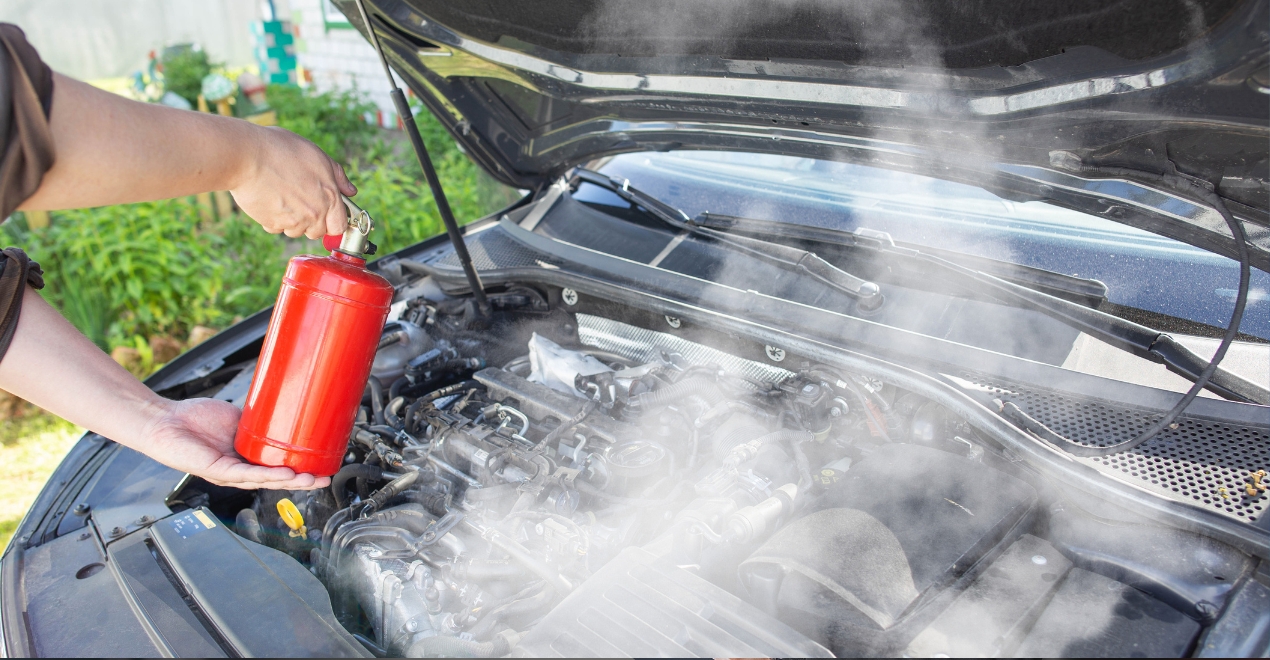White smoke emanating from a car’s exhaust can be an alarming sight for any driver. It signals that something is amiss within the vehicle’s engine system. One common but often misunderstood cause of white smoke is the presence of too much oil in the engine. This article delves into the reasons behind this phenomenon, the underlying mechanics, and the steps you can take to address and prevent it. We will explore the causes, symptoms, and solutions in detail, providing you with a comprehensive understanding of why overfilling your engine oil can lead to white smoke. Experiencing white smoke issues or worried about engine performance? Contact Crossroads Helpline today for expert advice and doorstep assistance.
Table of Contents
ToggleUnderstanding Engine Oil and Its Functions
Engine oil is a critical component for the smooth operation of an internal combustion engine. It serves several essential functions, including lubricating engine parts, reducing friction, and preventing overheating by dissipating heat. Additionally, engine oil helps to clean and protect the engine from corrosion and wear. Proper oil levels ensure that all these functions are carried out effectively, maintaining engine health and performance.
When engine oil levels are either too low or too high, it can lead to significant engine problems. Overfilling the engine oil, in particular, can cause various issues, including the production of white smoke. Understanding the role of engine oil and maintaining the correct levels is crucial for preventing engine damage and ensuring optimal performance.
How Overfilling Oil Leads to White Smoke
When too much oil is added to an engine, it can lead to a situation where the oil is whipped into a frothy, aerated state by the moving parts within the engine, such as the crankshaft. This frothy oil is less effective at lubricating the engine because it does not flow smoothly and consistently. Furthermore, the excess oil can exert excessive pressure on seals and gaskets, leading to leaks.
One of the primary reasons for white smoke in this scenario is the oil’s infiltration into the combustion chamber. When the engine is overfilled with oil, the excess oil can seep past the piston rings or valve seals and enter the combustion chamber. Once inside, the oil burns along with the fuel-air mixture, producing white or bluish-white smoke as a byproduct. This smoke is then expelled through the exhaust system, creating the visible white smoke often seen by drivers.
Additionally, overfilled oil can cause increased crankcase pressure, leading to oil being forced into the PCV (positive crankcase ventilation) system. The PCV system is designed to recycle unburned gases from the crankcase back into the combustion chamber for burning. However, when oil enters this system, it is also burned, contributing to the production of white smoke.
Identifying Symptoms of Too Much Oil in the Engine

Apart from the white smoke, several other symptoms can indicate that an engine has too much oil. Being aware of these signs can help you diagnose and address the issue promptly:
- Oil Leaks: Excessive oil can increase pressure on gaskets and seals, leading to leaks. If you notice oil spots under your vehicle or oil seeping from the engine, it could be a sign of overfilling. If you’ve pulled over due to a sudden oil leak or flat tyre, consider professional roadside services like flat tyre repair near me for quick assistance.
- Engine Misfires and Rough Running: When oil enters the combustion chamber, it can foul spark plugs, leading to misfires and rough engine performance. You might notice a decrease in power, rough idling, or hesitation during acceleration.
- High Oil Pressure: Overfilled oil can cause abnormally high oil pressure, which can be observed on the oil pressure gauge if your vehicle is equipped with one. High oil pressure can strain engine components and lead to further damage.
- Oil Smell: If you smell burning oil while driving, it could be due to oil burning in the combustion chamber or leaking onto hot engine parts like the exhaust manifold.
- Increased Smoke During Startup: White smoke may be more prominent during engine startup, especially after the car has been sitting for a while. This is because oil has had time to seep into the combustion chamber and is burned off when the engine is started.
Preventing Overfilling and Its Consequences
Preventing the overfilling of engine oil is relatively straightforward, but it requires attention to detail and adherence to recommended maintenance practices. Here are some steps you can take to avoid this issue:
- Check Oil Levels Regularly: Regularly checking your oil levels using the dipstick can help you monitor the correct amount of oil in your engine. Make sure to park your car on a level surface, turn off the engine, and wait a few minutes before checking to get an accurate reading. In emergencies where you’re stuck without fuel or dealing with oil-related issues, Crossroads also provides fuel delivery service for stranded vehicles to get you back on track.
- Follow Manufacturer’s Recommendations: Always adhere to the oil capacity specified in your vehicle’s owner’s manual. Overfilling can occur if you add more oil than recommended, so it is crucial to know the correct amount required for your engine.
- Use Quality Oil and Filters: Using high-quality oil and filters can help ensure that your engine is properly lubricated and protected. Quality oil also reduces the risk of sludge buildup, which can contribute to oil pressure issues.
- Monitor for Leaks and Symptoms: Stay vigilant for signs of oil leaks, burning oil smell, and other symptoms mentioned above. Early detection can help you address the problem before it escalates.
- Get Professional Maintenance: Regular maintenance by a qualified mechanic can help you maintain proper oil levels and identify potential issues early on. Professionals can also provide valuable advice on oil types and maintenance schedules.
Addressing White Smoke and Overfilled Oil

If you notice white smoke and suspect that your engine has been overfilled with oil, it is essential to take corrective action promptly to prevent further damage. If the damage is extensive and you cannot drive safely, it’s best to contact car towing assistance for safe transport to a service center. Here are the steps you can take:
- Drain Excess Oil: If you have overfilled your engine oil, the first step is to drain the excess. This can be done by removing the oil drain plug and allowing some oil to flow out until the correct level is reached. Make sure to dispose of the excess oil properly.
- Replace Fouled Spark Plugs: If oil has entered the combustion chamber, it may have fouled the spark plugs. Replacing these plugs can help restore proper engine performance and reduce misfires.
- Inspect Seals and Gaskets: Check for any damage to seals and gaskets caused by the excess oil. Replacing damaged components can prevent future leaks and ensure that your engine operates smoothly. Crossroads also offers automotive lockout help in case you’re locked out during an engine emergency.
- Clean the PCV System: If oil has entered the PCV system, it may need to be cleaned or replaced to prevent oil from being drawn into the combustion chamber.
- Monitor for Recurring Symptoms: After addressing the issue, continue to monitor your vehicle for any recurring symptoms of overfilling. Regular maintenance and oil level checks can help prevent the problem from happening again. In addition to oil-related support, their battery jumpstart service near you can revive your vehicle during power failures.
Conclusion
White smoke coming from a car’s exhaust due to too much oil is a clear indication of an underlying issue that needs immediate attention. Understanding the causes and consequences of overfilled engine oil can help you prevent and address this problem effectively. By maintaining proper oil levels, conducting regular checks, and seeking professional maintenance when needed, you can ensure the longevity and optimal performance of your engine. Remember, a well-maintained engine not only runs smoother but also saves you from costly repairs in the long run.

